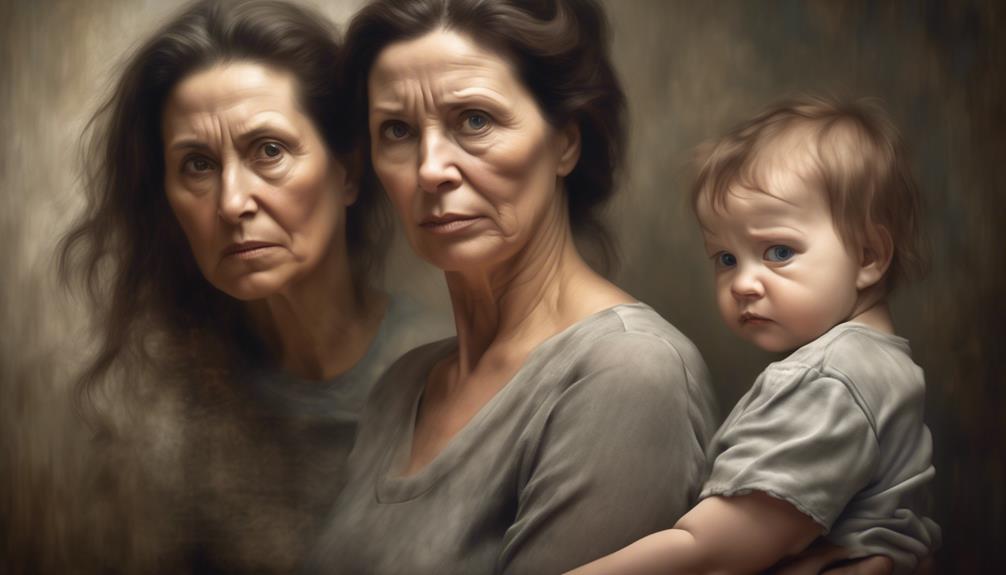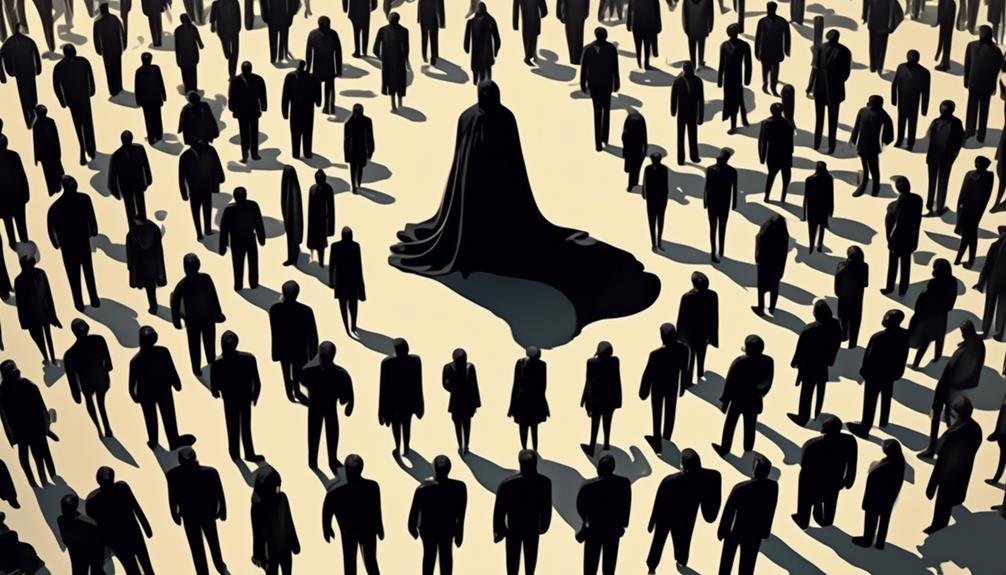Some may argue that the portrayal of fictional characters dealing with Borderline Personality Disorder (BPD) can oversimplify the disorder’s complexities or reinforce damaging stereotypes.
However, examining the portrayal of BPD in media offers a unique lens through which to explore the intricacies of this mental health disorder.
As we explore the multifaceted depictions of characters like Clementine from 'Eternal Sunshine of the Spotless Mind' and Anakin Skywalker from 'Star Wars,' we uncover a rich tapestry of experiences that can prompt us to reconsider our perceptions and deepen our understanding of BPD within the realm of storytelling.
Key Takeaways
- Characters like Clementine and The Hulk depict intense emotions and erratic behavior.
- Anakin Skywalker and Jessica Jones showcase struggles with emotional conflict and inner turmoil.
- Rebecca in 'Crazy Ex-Girlfriend' offers insight into raw emotions and challenges faced.
- Understanding and coping with inner turmoil are crucial themes in character portrayals.
Analysis of Clementine From Eternal Sunshine of the Spotless Mind
In dissecting Clementine from Eternal Sunshine of the Spotless Mind, we uncover a character beautifully portrayed by Kate Winslet, embodying a complex blend of impulsive charm and deep emotional turmoil. Clementine's personality resonates with traits commonly associated with Borderline Personality Disorder (BPD). Her impulsive nature, fear of abandonment, and struggles with identity mirror the characteristics often observed in individuals with BPD.
Throughout the movie, we witness Clementine's intense emotions and erratic behavior, showcasing the turbulent inner world that individuals with BPD often navigate. Her impulsiveness drives her actions, impacting her relationships and sense of self. The fear of abandonment is a recurring theme in her interactions, shaping her responses to situations and people around her.
Clementine's portrayal sheds light on the complexities of BPD and how it can manifest in different aspects of a person's life. Through her character, viewers gain insight into the challenges faced by individuals dealing with BPD, highlighting the importance of empathy and understanding towards those struggling with such emotional difficulties.
The Hulk's Portrayal in the Avengers

The Hulk's depiction in the Avengers vividly illustrates the tumultuous journey of a character grappling with intense emotions and struggles with identity, resonating with traits commonly associated with Borderline Personality Disorder (BPD). Throughout the Avengers movie franchise, The Hulk, also known as Bruce Banner, showcases characteristics such as fear of abandonment, self-destructive behavior, and challenges with emotional control. His transformation into the Hulk symbolizes an intense manifestation of the inner turmoil often experienced by individuals with BPD.
The Hulk's portrayal in the Avengers delves into his unstable relationships, trauma, and the profound fear of hurting those around him. His struggles with isolation and the difficulty of forming connections with others mirror the challenges faced by many individuals with Borderline Personality Disorder. The emotional depth of The Hulk's character emphasizes the complexities of managing overwhelming emotions and the ongoing battle to find a sense of self amidst chaos. In essence, The Hulk's portrayal serves as a poignant representation of the intricate nature of BPD within the realm of fictional characters.
Rebecca's Depiction in Crazy-Ex Girlfriend
Delving into the intricacies of mental health representation, Crazy Ex-Girlfriend vividly portrays Rebecca's journey with Borderline Personality Disorder (BPD). The fictional character of Rebecca Bunch from 'Crazy Ex-Girlfriend' often mirrors the struggles faced by individuals with a diagnosis of BPD. Her experiences of self-loathing, abandonment, and loss are magnified into raw emotions that resonate deeply with viewers. Through the lens of this TV show, Rebecca's character offers a poignant insight into the challenges of living with BPD.
Rebecca's depiction in 'Crazy Ex-Girlfriend' goes beyond surface-level portrayals often seen in other TV shows. The series delves into her inner turmoil, therapy sessions, and tumultuous relationships, providing a nuanced understanding of how BPD can manifest in everyday life. Her self-destructive tendencies and intense emotions are depicted in a way that humanizes her struggles, shedding light on the complexities of the disorder. Viewers witness Rebecca's journey towards self-discovery and healing, offering a glimpse into the realities of living with BPD.
Anakin Skywalker's Representation in Star Wars

Rebecca's portrayal in 'Crazy Ex-Girlfriend' offers a poignant exploration of Borderline Personality Disorder; similarly, Anakin Skywalker's depiction in Star Wars delves into themes of inner turmoil and emotional struggles.
Anakin Skywalker, later known as Darth Vader, navigates a tumultuous journey marked by deep emotional conflict and an intense identity crisis. His descent to the dark side mirrors a profound struggle with trauma, fear of abandonment, and the overwhelming weight of his emotions.
Throughout the Star Wars saga, Anakin's character grapples with the consequences of his choices, showcasing the complexities of managing impulsive behavior and intense feelings. His narrative sheds light on the challenges individuals with Borderline Personality Disorder face, emphasizing the importance of understanding and coping with inner turmoil.
Jessica Jones From Jessica Jones: a Character Study
Exploring Jessica Jones' character in the TV series 'Jessica Jones' reveals a compelling study of a woman grappling with past trauma and inner turmoil. Jessica Jones, a character with Borderline Personality traits, struggles with dependency issues, intense guilt magnified by her difficult relationship with her father, and a deep fear of abandonment. Her impulsive behavior and challenges in managing her emotions reflect the inner turmoil she constantly battles with.
Through Jessica Jones, viewers witness a relatable character who can validate the experiences of those dealing with similar struggles related to identity and emotions. Her portrayal sheds light on the complexities of living with Borderline Personality traits and the impact it can have on one's relationships and sense of self.
Jessica Jones' journey serves as a poignant reminder of the resilience and strength required to navigate the intricacies of mental health challenges.
Frequently Asked Questions
Which Fictional Character Has Bpd?
We can explore various fictional characters speculated to have traits of BPD, such as Harley Quinn, Clementine, and Anakin Skywalker. Each character exhibits emotional intensity and impulsivity akin to BPD traits.
However, pinpointing a single character definitively with BPD remains subjective due to the complexity of mental health depictions in fiction. Understanding these portrayals can offer insights into how BPD traits are represented in popular media.
Why Is BPD Life Expectancy 27?
We know why BPD life expectancy is 27. The challenges individuals face with BPD, like self-harm and substance abuse, can lead to risky behaviors impacting lifespan. It's a tough road, but with early intervention and proper treatment, outcomes can improve.
Comprehensive mental health support is crucial. By addressing these issues head-on, we can work towards increasing the life expectancy of individuals with BPD.
What Superhero Has Borderline Personality Disorder?
We believe that exploring the portrayal of mental health in popular culture can offer insights into complex human experiences. Fictional characters serve as mirrors to our own struggles, sparking discussions on mental health representation and fostering empathy and understanding.
Examining superheroes like Darth Vader for traits of Borderline Personality Disorder can deepen our grasp of psychological conditions and their impact on individuals, enhancing our ability to relate and support others.
Do People With BPD Get Attached to Fictional Characters?
We do indeed get attached to fictional characters. Their stories and struggles often resonate with us, providing comfort and understanding. Engaging with these characters allows us to explore and process our intense emotions in a safe way.
The depth and complexity of fictional characters can offer companionship and empathy, making us feel less alone in our experiences. This connection with fictional characters can be a valuable source of support for individuals with BPD.
Conclusion
As we reflect on the diverse portrayal of fictional characters with Borderline Personality Disorder, we're reminded of the intricate tapestry of human experiences.
Just like how a prism refracts light into a spectrum of colors, these characters illuminate the complexities and struggles of individuals living with BPD. Through their stories, we see the beauty and challenges of navigating intense emotions, identity crises, and impulsive behaviors.
Let's continue to embrace these narratives with empathy and understanding, recognizing the importance of mental health representation in media.
Val brings a wealth of knowledge and empathy to our team, crafting articles that touch the heart and enlighten the mind. As an expert writer, she dives deep into the subjects of BPD, offering informative and deeply relatable perspectives. Val’s contributions are instrumental in making complex psychological concepts accessible to our audience, helping to foster understanding and compassion.










